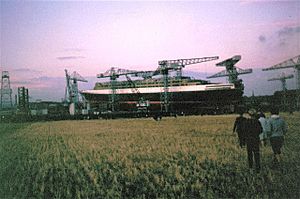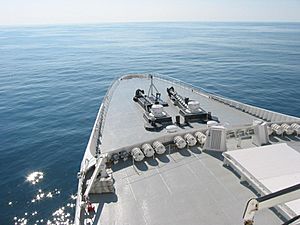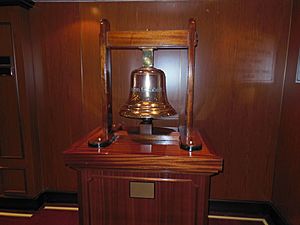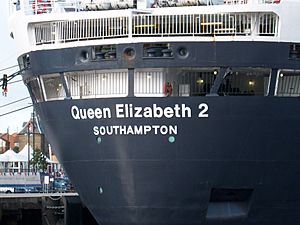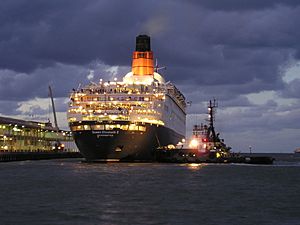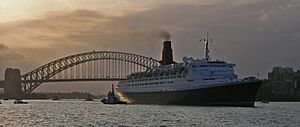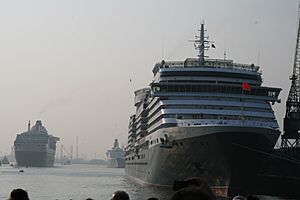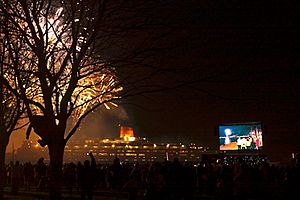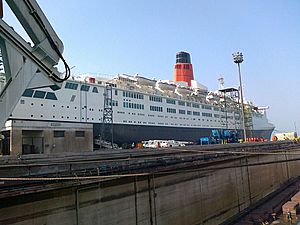Queen Elizabeth 2 facts for kids
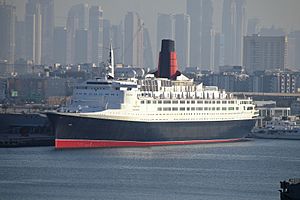
Queen Elizabeth 2 docked in Dubai in March 2020
|
|
Quick facts for kids History |
|
|---|---|
| Owner |
|
| Operator |
|
| Port of registry |
|
| Route | North Atlantic and cruising during Cunard service |
| Ordered | 1964 |
| Builder | John Brown and Company (Upper Clyde Shipbuilders), Clydebank, Scotland |
| Cost | £29,091,000 |
| Yard number | 736 |
| Laid down | 5 July 1965 |
| Launched | 20 September 1967 by Queen Elizabeth II |
| Completed | 26 November 1968 (Sea trials commenced) |
| Maiden voyage | 2 May 1969 |
| In service | 1969–2008 |
| Out of service | 27 November 2008 |
| Identification |
|
| Status | Floating hotel and museum at Mina Rashid, Dubai |
| General characteristics | |
| Tonnage | 70,327 GT |
| Displacement | 49,738 |
| Length | 963 ft (293.5 m) |
| Beam | 105 ft (32.0 m) |
| Height | 171 ft (52.1 m) |
| Draft | 32 ft (9.8 m) |
| Decks | 10 |
| Installed power |
|
| Propulsion |
|
| Speed |
|
| Capacity |
|
| Crew | 1,040 |
The Queen Elizabeth 2 (often called QE2) is a famous British ocean liner that now serves as a floating hotel. It was built for the Cunard Line and was the second ship officially named Queen Elizabeth. From 1969 to 2008, the QE2 sailed as both a ship crossing the Atlantic Ocean and a cruise ship. After being retired, it was turned into a hotel and opened in Dubai on April 18, 2018.
The Queen Elizabeth 2 was designed to travel between her home port of Southampton, UK, and New York, United States. It was named after an earlier Cunard ship, the RMS Queen Elizabeth. The QE2 was Cunard's main ship from 1969 until the Queen Mary 2 took its place in 2004. It was designed in Cunard's offices in Liverpool and Southampton and built in Clydebank, Scotland. Many people considered it the last great transatlantic ocean liner for a long time.
In 1986–87, the Queen Elizabeth 2 was updated with modern diesel engines. For almost 40 years, it made regular trips around the world. Later, it mostly operated as a cruise ship from Southampton, England. The QE2 always kept up Cunard's tradition of regular transatlantic crossings each year it was in service.
The Queen Elizabeth 2 stopped active service with Cunard on November 27, 2008. It was bought by Dubai World, which planned to turn it into a 500-room floating hotel. This hotel would be docked at the Palm Jumeirah in Dubai. However, due to the 2008 financial crisis, the ship was put on hold in Dubai. Plans for its conversion were announced again in 2012 and 2013, but these plans also faced delays. In 2017, a company announced it would refurbish the ship. The restored QE2 finally opened to visitors on April 18, 2018.
Contents
Building the QE2
By 1957, most people were choosing to travel across the Atlantic by plane because it was faster and cheaper. Older ships like the Queen Mary and Queen Elizabeth were becoming too expensive to run. Cunard, the shipping company, still wanted to offer transatlantic travel. So, they decided to build a new ocean liner, first called "Q3".
The Q3 was planned to be a very large ship, costing about £30 million. However, this project was cancelled in 1961. Cunard then decided to build a different "Queen" ship. This new ship, called "Q4", would be more flexible. It would be a three-class ship for eight months of the year, crossing the Atlantic. In winter, it would become a cruise ship in warmer places.
The Q4 was designed to be smaller than the older Queens. It would have one boiler room, one engine room, and two propellers. This design, along with automation, meant fewer crew members were needed. The new ship could travel at the same speed as the older Queens but would use half the fuel. This was expected to save £1 million a year! The Q4 was also designed to fit through the Panama Canal and Suez Canal. Its shallower draught (how deep the ship sits in the water) allowed it to enter more ports.
Ship Design and Features
The inside and outside of the QE2 were designed by James Gardner. His design made the ocean liner look like a "very big yacht." It was described as "sleek, modern, and purposeful."
Ship Size and Speed
When the QE2 retired, it weighed 70,327 gross tons and was 963 ft (294 m) long. With its original steam engines, the QE2 could reach a top speed of 32.5 knots (60.2 km/h). After it was updated with diesel-electric engines, its top speed increased to 34 knots (63 km/h).
The Hull and Superstructure
The ship's hull was built using welding, which saved a lot of weight compared to older ships that used millions of rivets. Unlike previous Queens, the QE2 also had a bulbous bow, which helps the ship move through water more smoothly.
The QE2 had a unique funnel (smokestack). At first, it wasn't painted with Cunard's traditional colors. Instead, it was white and black, with only a small touch of orange-red inside. This changed in 1983 after the Falklands War. Since then, the funnel has always been painted in Cunard's classic orange and black colors.
A lot of aluminium was used in the QE2's upper parts (superstructure). This made the ship lighter, helping it sit higher in the water and use less fuel. Special care was taken to prevent corrosion where the aluminum met steel.
In 1972, the first luxury suites were added to the ship. By 1977, more suites with balconies were added. This made QE2 one of the first modern ships to offer private balconies to passengers. The balconies were expanded again during a major refit in 1986/87.
Inside the Ship
The Queen Elizabeth 2's interior was designed differently from older liners. Spaces for different passenger classes were spread out horizontally on specific decks. The first-class deck was actually below the tourist-class deck.
The ship's designers used modern materials like laminates, aluminum, and Perspex. Public rooms featured glass, stainless steel, dark carpets, and sea-green leather. The furniture was modern, and abstract art was displayed throughout the ship.
Over its 39 years of service, the QE2 had many interior updates. In 1994, most of the original decor was changed. Cunard decided to go back to a more traditional look, inspired by their older ocean liners. For example, the Midships Bar became the Art Deco-inspired Chart Room. The Theatre Bar was turned into the Golden Lion Pub, designed to look like a traditional Edwardian pub.
By the time the ship retired, its synagogue was the only room that had remained unchanged since 1969. However, it was later removed from the ship before its final journey to Dubai.
Art and History on Board
The QE2 was filled with beautiful artwork and historical items from Cunard's long past.
For example, a sculpture of "White Horses" was in the Mauretania Restaurant. There were also bronze busts of Sir Samuel Cunard and Queen Elizabeth II. Four life-size statues representing the four elements, made from shells and coral, were in the Princess Grill. The Chart Room featured a frieze with words from famous writers. The Midships Lobby held a silver model of the Queen Elizabeth 2.
Three special tapestries were made for the ship's launch, showing the Queen and the ship's launch. These tapestries were originally hung in a main stairway.
The ship also displayed items from previous Cunard ships. These included a brass plaque from the first RMS Mauretania (1906) and an Art-Deco relief from RMS Queen Elizabeth. There were also many Cunard postcards, china, and model ships. A replica of the figurehead from Cunard's first ship, RMS Britannia, was also on board.
On the Upper Deck, you could find the silver Boston Commemorative Cup, given to Britannia in 1840. A bronze sculpture called Spirit of the Atlantic was on "2" Deck. A large wooden plaque honored the Queen Elizabeth 2 for its service as a troopship in the Falklands War. The ship also had many large models of Cunard ships.
Over the years, more items were added to the collection, like antique Japanese armor and a Wedgwood vase. Silver plaques throughout the ship marked visits from members of the Royal Family and other important people like Nelson Mandela.
Engines and Power
The Queen Elizabeth 2 first used a steam turbine system. It had three boilers that created steam for two turbines. These turbines powered the ship's two propellers.
However, the steam engines had problems and used a lot of fuel. By the 1980s, it was hard to find spare parts for them. After 18 years, the ship had traveled over 2.6 million miles! Cunard decided to replace the engines completely. They calculated that new engines would save money on fuel and maintenance, giving the ship at least another 20 years of service.
From 1986 to 1987, the steam turbines were removed. They were replaced with nine German diesel engines. These engines created electricity, which then powered two large electric motors connected to the propellers. This new system was more powerful and used 35% less fuel!
During this upgrade, the ship's funnel was replaced with a wider one to fit the exhaust pipes from the new diesel engines. The old fixed propellers were also replaced with variable-pitch propellers. This meant the ship could change the direction of its thrust without changing the direction the propellers spun, making it easier to stop and handle.
Other important machinery on board included boilers for heating, systems to turn seawater into fresh water, a sanitation system, air conditioning, and a steering system.
Building the Ship
On December 30, 1964, Cunard ordered the new ship from John Brown and Company in Clydebank, Scotland. The price was £25,427,000. The British government helped by providing a loan of £17.6 million.
The ship's construction began on July 5, 1965. It was built on the same slipway where famous Cunard liners like Lusitania, Aquitania, Queen Mary, and Queen Elizabeth had been built.
The ship was launched and named on September 20, 1967, by Queen Elizabeth II. She used the same gold scissors her mother and grandmother had used for previous Queen ships.
The Ship's Name
There's some debate about whether the ship was named after the monarch, Queen Elizabeth II, or the earlier ship, Queen Elizabeth.
The name on the ship's bow and stern is Queen Elizabeth 2, using a number "2" instead of the Roman numeral "II". This helps tell it apart from the monarch, Elizabeth II. Most people say "Queen Elizabeth Two." Soon after it launched, people started calling it "QE2."
When the Queen launched the ship, she said, "I name this ship Queen Elizabeth the Second." This was the usual way to address herself. However, when the ship left the shipyard in 1968, it had Queen Elizabeth 2 painted on its bow.
Some stories say that Cunard originally planned to name the ship simply Queen Elizabeth. The Queen's addition of "the Second" was a surprise. Cunard then decided to use the modern "2" instead of "II" to match the style of the 1960s.
Service Life
First Years at Sea
The Queen Elizabeth 2's first journey from Southampton to New York began on May 2, 1969. It took just over 4 days.
In 1971, the QE2 helped rescue about 500 passengers from a burning French ship called Antilles. In 1972, while sailing from New York, the ship received a bomb threat. The crew and a special military team searched the ship, but no bomb was found. The person who made the false threat was arrested.
The QE2 continued Cunard's tradition of regular transatlantic crossings every year. For a few years, after the French ship SS France (1960) stopped service in 1974, the QE2 was the largest passenger ship in the world.
In 1976, a fire broke out in the main engine room. The crew quickly brought the fire under control. The ship returned to Southampton for repairs.
By 1978, the ship was doing well, carrying many passengers. Its owners tried to keep it at sea as much as possible to avoid losing money when it was docked.
Serving in the Falklands War
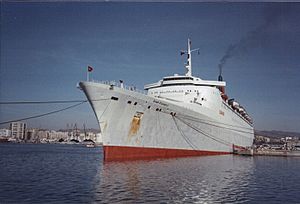
On May 3, 1982, the British government asked the QE2 to serve as a troop carrier during the Falklands War.
The ship was quickly prepared for war service. Two helicopter pads were added, and public lounges were turned into sleeping areas for soldiers. Fuel pipes were installed for refueling at sea. Over 650 Cunard crew members volunteered to care for the 3,000 soldiers on board.
On May 12, 1982, the ship left Southampton for the South Atlantic. It sailed without modern navigation aids and kept its lights off to avoid being seen.
The QE2 returned to the UK on June 11, 1982, and was welcomed by Queen Elizabeth The Queen Mother. The ship was then converted back for passenger service. During this refit, its funnel was painted in the traditional Cunard orange and black colors for the first time. The hull was also painted an unusual light grey, but this color was not popular and was changed back to traditional colors in 1983.
Diesel Power and Updates
The QE2 had more mechanical problems in the early 1980s. Instead of replacing the ship, Cunard decided to make major improvements. From 1986 to 1987, the QE2 underwent a huge refurbishment in Germany. Its steam engines were replaced with modern diesel engines, which cut fuel use in half. This upgrade cost over £100 million and was expected to keep the QE2 sailing for another 20 years.
On August 7, 1992, the ship's hull was damaged when it hit rocks near Martha's Vineyard. This happened because of its speed and an uncharted underwater obstacle. Passengers had to leave the ship early, and it needed temporary repairs.
In the mid-1990s, the QE2 received another major refurbishment to give it a new look.
On September 11, 1995, the QE2 encountered a huge rogue wave, estimated to be 90 ft (27 m) tall, caused by Hurricane Luis. One year later, during its 20th world cruise, the ship completed its four millionth mile. This meant it had sailed the equivalent of 185 times around the Earth!
In 1999, the QE2 celebrated its 30th anniversary. By then, it had made 1,159 voyages, sailed over 4.6 million nautical miles, and carried more than two million passengers.
Later Years and Retirement
In 1998, Carnival Corporation bought the Cunard Line. In 1999, the QE2 received a US$30 million refurbishment. Many public rooms were updated, and the passenger cabins got new colors. The ship was also repainted in Cunard's traditional black hull and white upper parts.
On August 29, 2002, the Queen Elizabeth 2 became the first merchant ship to sail more than 5 million nautical miles.
In 2004, the ship stopped its regular transatlantic route. This route was given to Cunard's new main ship, Queen Mary 2. The QE2 then focused on full-time cruising, though it still made an annual world cruise. Even though newer cruise ships had more features, the QE2 was still special with its ballrooms, hospital, and a library with 6,000 books. It remained the fastest cruise ship afloat.
On November 5, 2004, the Queen Elizabeth 2 became Cunard's longest-serving express liner. On September 4, 2005, it became the longest-serving Cunard ship ever.
In 2005, some artwork on the ship was damaged by crew members after a party. A unique tapestry of the Queen Elizabeth 2 was even thrown overboard. The crew members involved were dismissed.
On February 20, 2007, the Queen Elizabeth 2 met its successor, QM2, in Sydney Harbour, Australia. This was a special moment, as it was the first time two Cunard "Queens" had been together in Sydney since 1941.
Retirement Announcement
On June 18, 2007, Cunard announced that the QE2 had been bought by the Dubai investment company Istithmar for $100 million. One reason for its retirement was new safety rules that would have required expensive changes to the ship.
Final Journeys
Before its retirement, the Queen Elizabeth 2 met Queen Victoria and Queen Mary 2 near the Statue of Liberty in New York Harbor on January 13, 2008. This was the first time three Cunard "Queens" were in the same place. They met again in Southampton on April 22, 2008.
On October 3, 2008, the QE2 began its farewell tour of Ireland and Britain. It visited places like Cork, Belfast, Greenock, and the Firth of Forth. Huge crowds gathered to see the ship one last time.
Last Atlantic Crossings
The QE2 completed its last Atlantic crossings with the QM2. They sailed together from Southampton on October 10, arriving in New York City on October 16. The two ships then left New York together on October 16, arriving back in Southampton on October 22. This was the end of the QE2's transatlantic voyages.
Final Voyage
On its final arrival in Southampton on November 11, 2008, the QE2 briefly ran aground on a sandbank. Tugs quickly pulled it free, and no damage was found.
The Queen Elizabeth 2 left Southampton Docks for the very last time on November 11, 2008, beginning its "QE2's Final Voyage." Its ownership officially passed to Nakheel Properties of Dubai World on November 26. At the time of its retirement, the QE2 had sailed 5.6 million miles, carried 2.5 million passengers, and completed 806 transatlantic crossings.
Life After Retirement
In Dubai
The QE2's final journey from Southampton to Dubai began on November 11, 2008. It arrived on November 26, led by MY Dubai, the personal yacht of Sheikh Mohammed, the ruler of Dubai. Thousands of people gathered to welcome the ship. Since its arrival, the QE2 has been docked at Port Rashid.
The plan was to refurbish the ship and dock it permanently at Nakheel's Palm Jumeirah. It would become a luxury floating hotel, shops, museum, and entertainment spot. However, due to global economic challenges, the QE2 remained docked at Port Rashid for a long time.
Despite rumors of the ship being sold, its owners, Istithmar, said that plans for its conversion were still happening. The only visible change to the QE2 after arriving in Dubai was that the Cunard names were painted off its upper structure.
The QE2 was visited by other Cunard "Queens" in Dubai, including the QM2 and QV, and the new Queen Elizabeth.
In June 2009, there were rumors that the Queen Elizabeth 2 would return to the UK. However, on July 20, 2009, the owners Nakheel confirmed that the QE2 would move to Cape Town, South Africa, to be a floating hotel for the FIFA World Cup 2010. The ship went into drydock for exterior refurbishment, and its home port was changed to Port Vila, Vanuatu. But in January 2010, it was confirmed that the QE2 would not move to Cape Town.
Recent Years in Dubai
In early 2010, due to financial difficulties, there was talk that the QE2 might be sold. However, Nakheel stated that "a number of options" were being considered for the ship.
On January 28, 2011, during a heavy dust storm, the QE2 broke free from its moorings and drifted into the channel at Port Rashid. Tugs quickly brought it back safely to its berth.
Throughout 2011 and 2012, the QE2 stayed docked at Port Mina Rashid in Dubai. It was kept in good condition by a crew of about 50 people. Each of its nine diesel generators was used to power the ship.
In September 2011, there was a plan to bring the QE2 back to Liverpool, UK, because of the city's strong historical connection with Cunard Line. However, Nakheel later announced that the QE2 would remain at Port Rashid as part of a new cruise terminal development.
On December 31, 2011, the Queen Elizabeth 2 hosted a large New Year's Eve party in Dubai.
On July 2, 2012, the ship's owners announced that the QE2 would reopen as a 300-bed hotel after an 18-month refurbishment. The plan was to restore its original features and dock it next to a new cruise terminal that would also be a maritime museum.
In December 2012, there were reports that the QE2 had been sold for scrapping in China. However, Cunard called these reports "pure speculation." The "QE2 London" plan had proposed buying the ship and refurbishing it to create jobs in London.
On January 17, 2013, Dubai Drydocks World announced that the Queen Elizabeth 2 would be sent to an unknown location in Asia to become a luxury hotel, shopping mall, and museum.
50th Anniversary and Reopening
September 2017 marked the 50th anniversary of the QE2's launch. Cunard Line held a special commemorative cruise. In Glasgow, a conference was held to celebrate the anniversary. Several books about the ship were also released.
The Queen Elizabeth 2 finally reopened in Dubai as a floating hotel on April 18, 2018. It underwent a huge refurbishment, taking over 2.7 million hours of work to upgrade it to hotel standards. This included repainting the hull and changing its home port on the stern to Dubai.
The ship now features a new QE2 Heritage Exhibition, which tells the story of the vessel. It is operated by PCFC Hotels, a company owned by the Dubai government. In May 2022, the French hospitality group Accor took over the hotel's operation. Accor plans to renovate the ship further, aiming for 447 hotel rooms.
The ship's theater regularly hosts shows, including comedians, tribute acts, and family shows.
Images for kids
-
Queen Elizabeth 2 back on the River Clyde for her 40th birthday in 2007
See also
- RMS Queen Elizabeth
- RMS Queen Mary
- RMS Queen Mary 2
- MS Queen Elizabeth


